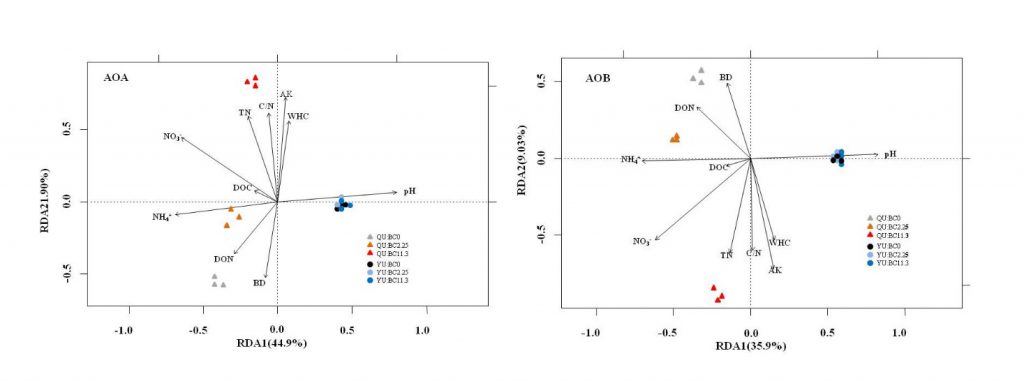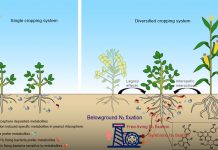硝化作用是决定作物氮素吸收、损失、土壤酸化、温室气体排放等过程的重要途径之一,是土壤氮转化的关键核心过程。近年来,黑炭已被作为农田固碳减排和改良土壤的潜力措施;前期关于黑炭介入下土壤硝化作用的响应的研究大多是通过黑炭-土壤的室内短期培养(<2年)来完成,目前尚缺乏关于长期黑炭介入下土壤硝化作用及氨氧化微生物的影响研究。
基于此,常熟站工作人员利用宜兴基地2011年建立的秸秆炭化还田土柱试验平台,对比分析了连续施加秸秆黑炭4年8季后酸性红壤和碱性潮土的硝化能力和氨氧化微生物群落结构的变化。结果表明,长期黑炭施加提高了酸性红壤pH值及营养元素含量,显著提高了其硝化潜力及氨氧化微生物的基因拷贝数;同时,氨氧化细菌AOB的优势物种Nitrosospira cluster 2逐渐向Nitrosospira cluster 3a /cluster 3b转化,且逐渐出现了与碱性潮土中相同的优势菌群,表明秸秆黑炭在修复红壤酸度和繁荣硝化微生物方面的作用。而长期黑炭施加对碱性潮土的硝化潜力及氨氧化微生物的群落组成并没有产生显著的影响。本研究首次利用高通量测序手段比较揭示了长期种植作物和秸秆黑炭连续施用下红壤和潮土氨氧化微生物群落结构的不同响应,能加深黑炭施用对农田土壤硝化作用影响的认识,也可为长期黑炭介入下土壤氮素损失调控提供一定的理论支撑。
He LL, Bi YC, Zhao J, Cameron M. Pittelkow, Zhao X, Wang SQ, Xing GX. Population and community structure shifts of ammonia oxidizers after four-year successive biochar application to agricultural acidic and alkaline soils. Science of the Total Environment, 2018, 619-620: 1105-1115
Abstract
Long-term studies that advance our mechanistic understanding of biochar (BC)‑nitrogen (N) interactions in agricultural soils are lacking. In this study, soil potential nitrification rates (PNR), the abundance and composition of ammonia-oxidizing archaea (AOA) and ammonia-oxidizing bacteria (AOB) communities following 4-year of BC application were investigated using the shaken-slurry procedure and molecular sequencing techniques for an acidic Oxisol (QU) and an alkaline Cambisol (YU). Soils were obtained from an outdoor soil column experiment with straw-BC application rates of 0 (BC0), 2.25 (BC2.25) and 11.3 (BC11.3) Mg ha− 1 per cropping season for eight consecutive wheat/millet seasons. Quantitative polymerase chain reaction (qPCR) and 454 high-throughput pyrosequencing techniques were performed to quantify and sequence amoA gene copies and composition of AOA and AOB. Results showed that QU had lower PNR and a higher ratio of amoA gene copies of AOA to AOB than YU, PNR of QU with BC application was significantly associated with the amoA gene of AOB. Similar to previous short-term findings, BC application enhanced QU soil nitrification, which may be explained by the significant increase in AOB abundance and a shift in AOB community structure from Nitrosospira cluster 2 toward cluster 3, along with the disappearance of some obligate acidophile AOA groups, leading to the appearance of ammonia-oxidizers from neutral-alkaline soils in BC-amended acid soils. Canonical correspondence analysis (CCA) showed that soil pH was the most important factor driving shifts in ammonia-oxidizers composition. Although BC application did not have significant effects on PNR in YU, BC11.3 decreased AOA and AOB gene copies and influenced the relative abundance of community structure. Our findings represent the first investigation of long-term BC effects on AOA and AOB communities in agricultural soils using 454 high-throughput pyrosequencing, showing that BC application can alter soil characteristics and influence ammonia oxidizer community composition, abundance, especially in acid soils.









